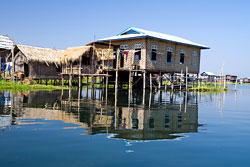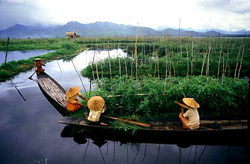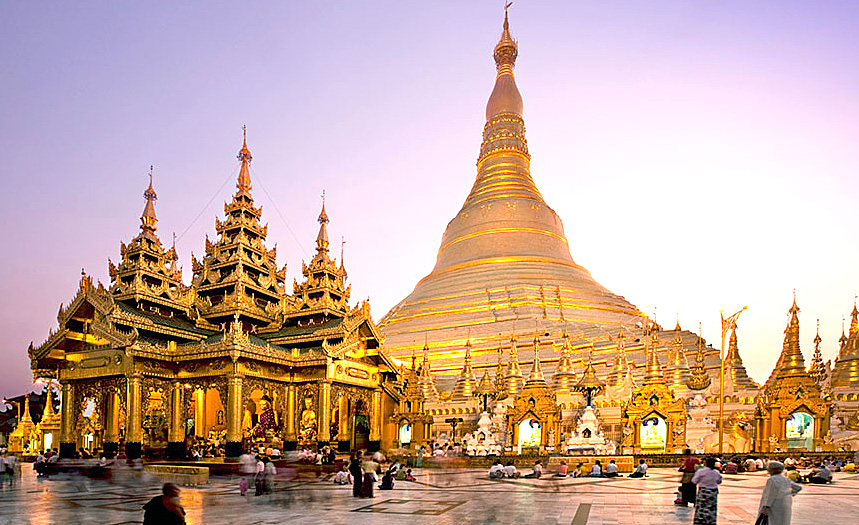Photo Tour Itinerary
FEBRUARY 20
Bangkok to Yangon, Yangon to Mandalay

After arrival Yangon International Airport (RGN), proceed to ground floor visa kiosk for visa processing (first-come, first-served), and after retrieving luggage, clear immigration (visa-on-arrival authorization required*), and meet escort in terminal and after introductions, transfer to domestic terminal for domestic flight to Mandalay.
Mandalay, the historic old capital that remains the spiritual capital of Myanmar. It is also where traditional arts and crafts are centered, rich with historical sites, cultural memorials and Buddhist monuments which we will begin to explore after arrival. At dusk, we'll trek up Mandalay hill providing panoramic views over the palace and river, an ideal location for stunning landscape shots. In the evening, sightseeing in central Mandalay and orientation dinner featuring the unique blend of local Indian, Burmese and Chinese culinary influences. (D)
*Visa-on-arrival authorization is required in advance of arrival (arranged by Indochina Travel)
Mandalay Hill View
FEBRUARY 21
Mandalay & Amarapura

Mandalay & Amarapura

At dawn, sightseeing by car and boat outside Mandalay, visiting the former royal capital of Amarapura and strolling along nearby U Bein Bridge, a striking 200 year-old bridge and the longest teak one in the world. Although little is left of the old capital, Amarapura is today known for its traditional silk and cotton weaving, and bronze casting, an we'll pause to engage and watch local artisans in their craft.
Midday, return for lunch and sightseeing in central Mandalay, including notable temples, arts and crafts shops, and galleries, including Mahamuni Pagoda, Shwe Inbin Monastery, and Shwenandaw Monastery, noted for its exquisite wood carvings; Kuthodaw Pagoda, renowned for its stone slabs of the Buddhist scriptures, and local galleries (Maharnadi) and artisans, including highly-regarded gold-leaf producers and silversmiths.
Dinner and accommodation in Mandalay. (B,L)
Although Mandalay is well known for its literary fame from a colonial-era past, the city itself is largely newer construction. In the 1980s, the city was hit by two major fires that destroyed tens of thousands of buildings and much of the central area of the city are buildings erected since that time. Many of the recent inhabitants are also new, an estimated 300,000 ethnic Chinese have recently made the city their home.
FEBRUARY 22
Mandalay to Inle Lake

This morning after a leisurely breakfast, return to Mandalay airport for a short flight into the mountains of the Shan state (30 minutes by air). After arrival at Heho airport, continuing overland into the picturesque Inle basin. Following lunch overlooking the waters, we'll begin a half-day cruise over the lake, admiring and photographing the famous fisherman rowing in their one-legged style. Our boat will glide between the stilted homes of villages, and we'll pause to explore on foot as well. In the late afternoon, enjoying sunset on the lake before dinner. (B,L)
Aureum Inle Resort
Inle Lake, located nearly one thousand meters above sea level is nearly sixty miles long over three main bodies of water and with over two hundred villages noted for their unique stilt houses and "floating islands" over the water. Highlights in this tranquil setting include fisherman rowing in the one-legged style and the rich tapestry of hilltribes in the region.
Inle Lake is one of the most fascinating places in Southeast Asia, featuring beautiful natural landscapes and man made ones, including the striking "floating islands" if the Intha tribe who grow crops on buoyant beds water hyacinth (primarily tomatoes) and build their homes on stilts over the water. Please see our Inle Lake page for more on this special place.

FEBRUARY 23 & 24
Inle Lake

We'll spend two full days exploring sublime Inle Lake, featuring the most fascinating natural and man made landscapes in all of Myanmar. We'll rise at dawn to capture fisherman rowing in the eccentric one-legged style, passing villages built over the water on stilts with their unique, vertical floating islands on which they raise tomatoes and other crops. Also exploring the Nan Pan "5-day market," and Indein, a village popular for it's collection of 17th century pagodas.
We'll also visit with and learn the differing customs and lifestyles of the Intha, Pa'o, and Palaung people who inhabit the lake area, as well as the Padaung, or "long-necks," learning about the unique custom of neck rings.

Each day, rising at dawn to witness fisherman rowing in the eccentric one-legged style; passing villages built over the water on stilts with their unique, "floating islands" and cruising by boat to visit villages, cottage industries, including one with women of the famous Padaung hill tribe. Here, local workshops also produce paper and traditional crafts we'll observe before visiting Indein, a village with hundreds of ruins scattered among the vegetation. We will also stop into to visit a local daycare, high school and monastery of the Intha tribe who inhabit the lake. Also exploring the Nan Pan "5-day market," and Indein, a village known for it's collection of 17th century pagodas, meeting with village elders, local families, and monks.
One morning, by preference, visiting the Inle Wetland Wildlife Sanctuary at sunrise, an area established in 1985 for the safety of migratory birds and their habitat. To date, 254 bird species have been recorded, including the rare Jerdon's Bushchat and Sarus Crane (the best time for viewing migratory birds is from December to May). (B,L)
We recommend dinner at the nearby Inle View Resort (about 1/2 mile south of the Pristine Lotus)
The Nan Pan Market, large and bustling, where one can find a real local atmosphere with a variety of produce from the lake but the real attraction at the market are the variety of hilltribes in the area who come to trade, including the Palaung, Pao, and striking Padaung ("long-necks") who collect their home-made products and come to trade and sell, traveling in boats to the market while others by land.

Interestingly, the Padaung are actually a Mongolian tribe who have been assimilated into the larger Karen ethnic group. The Padaung only number several thousand, but attract a lot of interest for their practice of neck stretching. The custom is more than just a rare and certainly strange expression of beauty — the number and value of the rings confers status and respect on the wearer's family. The process begins when girls or around five or six, then continues with successive ring being added every two years. Padaung women can wear up to 45 pounds of the heavy brass rings around their necks.
The Palaung hilltribe (not the Padaung long necks), common in the Inle area, derive their income from tea. It is said that about five hundred years ago the King of Shan state demanded tribute from the Palaung, who being animist, tribal and living a subsistence life could offer nothing. The king gave them tea and taught them how to cultivate it and today it is their cash crop. In recent history, the area was ideal for growing poppies for opium cultivation, but almost all growers have converted to other specialty crops unique to the high-altitude area, such as mandarin oranges, bananas, and tea (local Tea shops are typically the center of life and social activity in any town and a good place to sample the local product)
FEBRUARY 25
Inle to Bagan

After a leisurely breakfast watching the sunrise over the lake, we'll enjoy a final cruise on the lake before returning to Heho Airport for our short flight to Bagan.
Henri Yule, one of the first Westerners to see Bagan in 1855 wrote in his reflections: "The whole, as seen from the river, might pass for a scene in another planet, so fantastic and unearthly was the architecture."
You will savor this same view from above as we descend over the Bagan plain. After arrival, transfer to hotel and as the day wanes exploration of Bupaya, a Pyu-style stupa which is located on the banks of the Ayerwaddy River. At dusk, enjoy refreshments at resort while the sun sets over the temple plain. (B,L)
Aye Yar River View
Bagan
Bagan was the capital of Burma for two and a half centuries (1044-1286 A.D.) under which a dynasty of temple-builders, the kingdom of Bagan became strong and powerful. During this period an estimate 4.500 temples were built of which just over 2,000 survive, spread over 40 square kilometers. Several of these monuments are still highly venerated by the population, and attract numerous pilgrims and devotees from all over the country, particularly at festival times. Obviously worthy of designation, as far back as 1996 UNESCO has attempted to designate Bagan a World Heritage site but has not succeeded in garnering cooperation from the government.

FEBRUARY 26 & 27
Bagan

During the next two days, exploring and photographing the ruins. At dawn, we'll enjoy spectacular views, photographing as the sun rises over the plain.
During our sightseeing tour of one of Asia's most renowned archaeological sites, visiting several of Bagan’s distinctive pagodas including Ananda Pagoda, one of the finest, largest and best preserved in Old Bagan, and next to it, Ananda Ok Kyaung, one of the few surviving brick monastery buildings from the Early Bagan period. Also Thatbyinnyu, Sulamani, 11th-century Shwezigon Pagoda , and Wetkyi-in- Gubyaukgyi, a 13th century ‘cave temple with interesting fine frescoes. We'll also visit the walled ruins of Old Bagan and local villages near the plain.
Balance of our days visiting primary or secondary temples, including the distinctive Dhammayangyi Pahto, a massive, later period temple with the finest brickwork in Bagan. As the sun goes down, At sunset, we'll commence a scenic boat ride on the Irrawaddy upstream, views on board. (B,L)
FEBRUARY 28
Bagan to Yangon

This day, a final morning of sunrise shooting before returning to the resort for breakfast. Balance of day photographing temples and after lunch, brief time to relax before we board our flight to Yangon.
In the afternoon, strolling over to nearby Scott Market for our first glimpse of the busy city. The historic market, a sprawling 80 year-old complex is noted for its variety of handicrafts and other items from throughout the country. After freshening up, we'll enjoy dinner in town and then continue strolling the downtown area at night. (B,L)
At the moment, Yangon does not have many international restaurants. Top options include Le Planteur, offering pleasant tropical garden dining, the 50th Street bistro, Indian at Coriander Leaf (near the Governors) or sophisticated Thai at Sabai Sabai.
Governor's Residence
MARCH 1
Yangon

Our last full day of exploring and photographing will be spent in the aged Yangon, where shanty towns front gleaming new office towers. Locations include rising at dawn to visit the awe-inspiring Shwedagon Pagoda, Myanmar's most sacred pagoda, well before the tour buses arrive. Also Chaukhtatkyi Pagoda, a colossal reclining Buddha; and the National Museum, rich with an abundance of artifacts and cultural exhibits of Myanmar, followed by exploration of Botataung Pagoda which retains many ancient relics.

Afterwards, lunch in Chinatown and in the afternoon, driving to the Bahan Township for a glimpse of rural Yangon and to visit the Myanmar Women's Development Association focused on education and training for women while providing for health care and other needs.
In the evening, we'll enjoy our farewell dinner with live, traditional musical performance. (B,L,D)
Yangon (Rangoon) is the largest city in Myanmar, with over four million inhabitants. Located in the Irrawaddy delta, it is surrounded by water on three sides. A legacy of the British presence in remains in structures that were built between the mid-19th century and the outbreak of World War II in 1940. Some Yangon hotels are located in old renovated buildings, including the Strand Hotel and Governors. The well-known Strand Hotel built in 1901 was at one time along with the Oriental Hotel in Bangkok, was one of the top Hotels in Southeast Asia. Restored and furbished with some modern-day amenities, the Strand still retains some original fittings such as teak wainscoting, ceiling fans, marble bathrooms, canopied beds and Burmese works of art.
MARCH 2
Depart Yangon
After farewell breakfast with escort staff and Mark Tuschman, return to airport for international flight home through Bangkok, Singapore or Taipei. Also, consider extending your trip out to the white sands of Ngapali beach, the southern Thai Islands or exploring the magnificent temples at Angkor. We can also arrange for a delightful city tour of Bangkok en route to Yangon or following this trip. (B)

